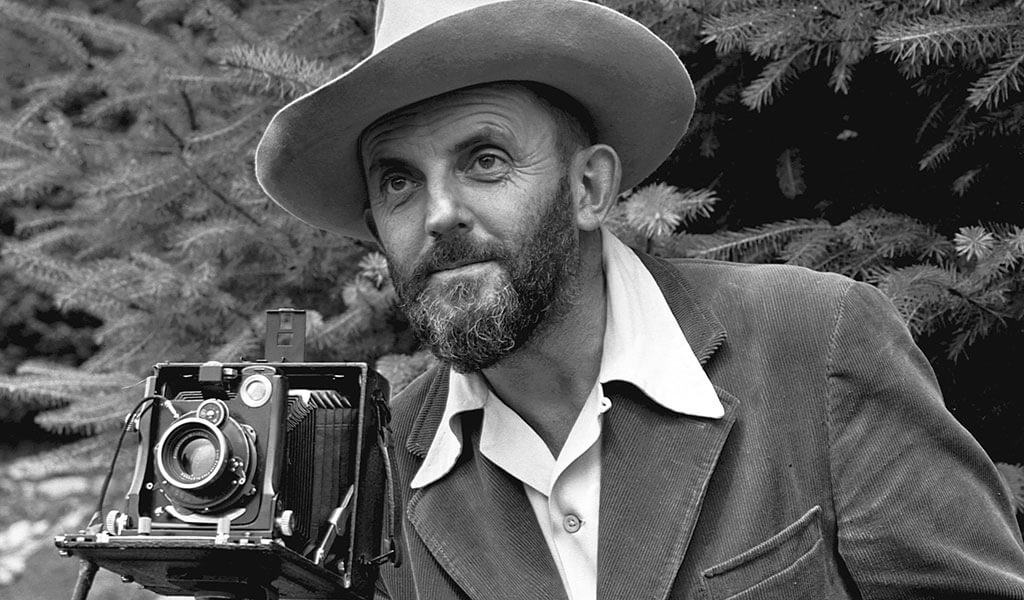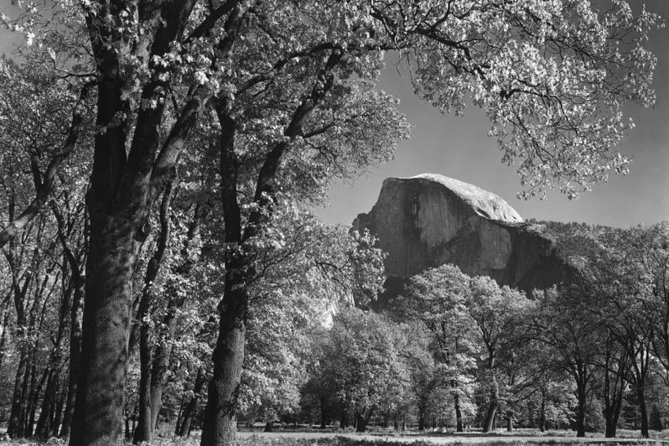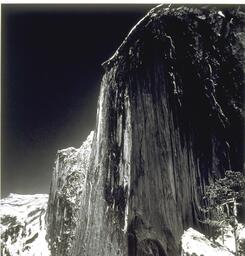Ansel Adams
Ansel Adams was born 20th February 1902, in San Francisco California and died 22nd April 1984, in Carmel California. He was an American photographer and environmentalist, who was the most important landscape photographer of the 20th century, creating black and white landscapes, and even creating the zonal system. His work has continued to increase in popularity since his death and now inspires many other artists, such as Robert Adams, Judy Dater, Robert Dawson, Minor White, Ted Orland and many more.
Ansel Adams was a hopeless and rebellious student, until his dad removed him from school at the age of 12. He then became a serious musician as a highly gifted pianist, until he fell and broke his nose and lost his confidence. After he received his first camera in 1916, Adams also proved to be a talented photographer. Throughout the 1920s, when he worked as the custodian of the Sierra Club’s lodge in Yosemite National Park, he created impressive landscape photographs.

Group f64?
In 1930 he met the American photographer Paul Strand and was shown the negatives that Strand was then making in New Mexico. Adams was deeply impressed with the simplicity of the images’ conception and by their rich and luminous tonality, a style in contrast to the soft-focus Pictorialism still in vogue among many contemporary photographers. The experience confirmed in him his evolution toward a purer and more realistic style. In 1932 Adams helped form Group f.64, a loose and short-lived association of West Coast photographers (including Edward Weston and Imogen Cunningham), who favoured sharp focus and the use of the entire photographic grey scale, from black to white, and who shunned any effects borrowed from traditional fine arts such as painting.

What is the Zonal System?
Ansel Adams created the zonal system, so he could predict what the exposure would need to be for his visualisation of his landscape, so he could get his visualisation quicker and correct.
Ansel Adams base rule was:
‘Exposure for the shadows, develop for the highlights.’
The zone-system of Ansel Adams divides the photo into eleven zones; nine shades of grey, together with pure black and pure white.
This zonal system was used, so he could create the photograph he was visualising. This zonal system helped him get his visualisation correct quicker, because he could not just take multiple tries for free, like we can today. This zonal system was also what he used to create his black and white pictures, as 0 was pure black, 5 was middle grey and 10 was pure white. However, you could assume that a normal photo does not contain pure black and pure white.

How did he use Romanticism and the sublime?
Ansel Adams produced photographs using the sublime, because he took photos of different parts of nature, such as mountains, waterfalls, rivers, cliffs etc, which are places that support the sublime, because they can be admired and create a sense of awe, while also creating a sense of panic and danger, because these parts of nature can be very strong and violent, because of their power and strength, or there mass/ height.

Adams created romanticism images as he took pictures of different parts of nature again, such as forests, trees, mountains, flowers etc, which supports romanticism, because romanticists believed that nature should be admired and create a sense of awe, because of its beauty. Adams presented the beauty of the nature through all his different photographs.

Who did he influence?
Ansel’s photography has had great impact, not only in awakening people to the beauty of nature but in inspiring many other photographers to turn their efforts to the natural scene and to use photography in the interests of environmental preservation.
Ansel Adams was influenced by Paul Strand, because his images had a powerful impact on Adams and helped him to move away from the pictorial style, which Adams and favoured in the 20s and focussed him more on the sublime and on the beauty and awe of nature, while also capturing the strength and power of it.
Ansel Adams has left a legacy to everyone by creating visually unforgettable images of unspoiled nature in spectacular places. He has paved the way for photography to be exhibited beside traditional painting and portraiture in national galleries. He is remembered for his most important work, which was devoted to what was or appeared to be the country’s remaining fragments of untouched wilderness, especially in national parks and other protected areas of the American West. He was also a vigorous and outspoken leader of the conservation movement.
Ansel Adams inspired people by making photography more creative by saying:
‘You don’t take a photograph, you make it.’
This influenced many other photographers to become more creative with their work, like Ansel Adams did instead of just taking pictures that looked ‘pretty’ and were the ‘norm.’

Most Popular Work
Ansel Adams favourite and most popular photograph was the Half Dome in full shadow in the Happy Isles. He travelled from his home there with his fiancée, Virginia, and two friends to begin a photoshoot.

He used a Korona View Camera with two lenses, two filters, a wooden tripod and twelve wratten panchromatic glass plates.
Firstly, he attempted to take the photo using an 8 1/2 inch focal length and made his first exposure of 11, using a wratten no. 8 k2 yellow filter. This image did not fit his visualisation. Next, he used his deep red wratten no. 29 with the shutter release for 5 second exposure at f/22. He then achieved his visualisation.
Image Analysis

I have chosen this image to analyse, because I think it portrays the sublime in Romanticism very well, as Adams has used the clouds/fog to his advantage, to show how strong and powerful they really are, as they cover the entire ground and most of the trees. However, he also uses them to show the beauty of the nature in this photograph.
Ansel Adams used natural lighting, while he was positioned on top of a mountain, while taking an image of the surroundings and down below. He used a high contrast of white and blacks throughout this whole image. He also used high exposure for the lighter areas and lower exposure for the darker areas, so he could create that contrast.
Adams created a black and white image with dark and light tones throughout, with lots of texture throughout (the trees, mountains, clouds). He also used leading lines in his image, so that the viewers eyes follow the line down the picture, until they reach the viewpoint. The viewpoint in the image was the low ground, where the mountains were surrounding. He also used depth of surface illusion in this image, to attract the viewers attention more.
This image was taken on the West side of America, because Adams believed the weather was better for photographs on this side of America, because it was darker and colder and changed more, compared to California where it was always sunny. This helped him create the sublime in Romanticism better, because the weather was more powerful here.
I think Ansel Adams took this image, so he could portray the sublime and move away from just ‘pretty sunsets.’ He showed ‘bad weather’ and made it beautiful, but also scary, because of its strength and power.

Jessica, overall very thorough and focused research on Romanticism. the Sublime, Landscape genre and Ansel Adams – well done!
Now you must plan photoshoots and match your creativity in producing some stunning landscape images in response to the above.